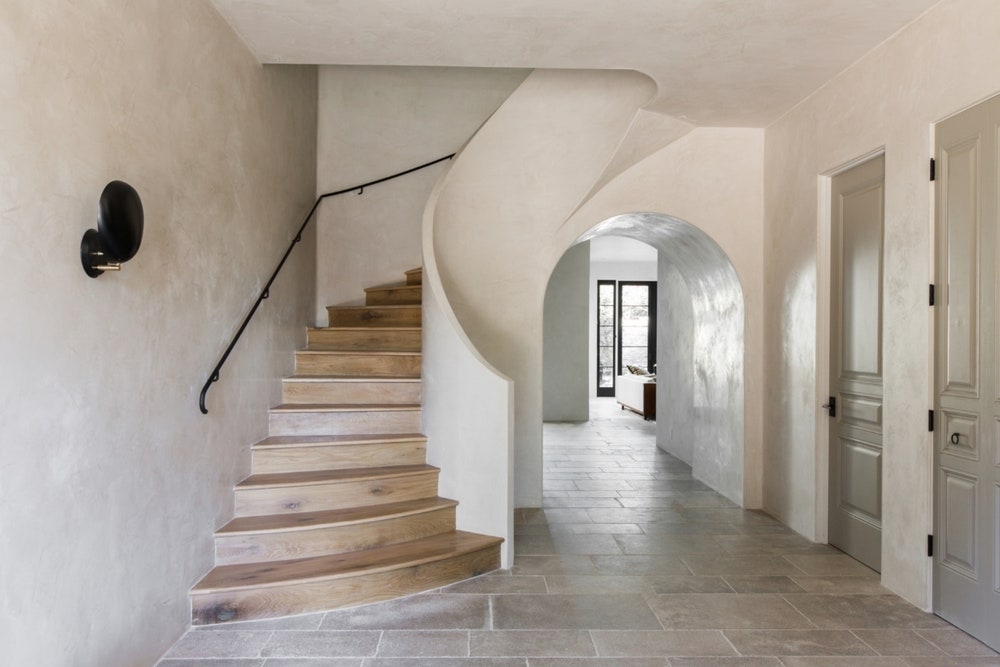Why Designers Are Embracing This Classic Material Again
Plaster has been a staple in construction since the era of the ancient Egyptians. In the United States, it played a significant role in residential building prior to World War II. Its long-standing popularity can be attributed to its ease of application and remarkable durability. Before the standardization of lumber dimensions in 1924, plaster was the material of choice for creating perfectly flat and uniform walls.
As the saying goes, “what’s old is new again”: Gypsum wall finishes have recently emerged as the favored option for upscale home renovations, replacing alternatives such as paint, wallpaper, or exposed brick.

A Resurgence in Plaster Finishes
Recently, gypsum wall finishes have gained traction in projects led by prominent designers and architects nationwide. Homeowners are also showcasing their newly updated plaster walls on social media platforms like Instagram. For instance, the plaster finishes in a renovated Pennsylvania farmhouse, highlighted in Curbed’s House Calls column, feature a textured surface that complements the home’s rustic aesthetic. This trend has piqued our interest, prompting us to explore its underlying causes.
With advancements in technology and creative experimentation, plaster now offers a diverse range of colors and textures comparable to paint. This versatility allows designers and architects to move away from the monotonous uniformity that plaster once facilitated.
Emily Farnham, an architect based in Los Angeles, notes, “What draws people to plaster today is the opportunity for subtle surface variations, adding character to what would otherwise be a flat surface. Many find the sterile, consistent nature of new construction surfaces unappealing.

Plaster is recyclable material which is typically produced from limestone (calcium carbonate) or gypsum (calcium sulfate). The raw materials are extracted from the earth, processed through heating and grinding into a fine powder. Various additives, such as sand or marble, are mixed into the powder to create different textures and colors in the final plaster product. After combining the powder with water, the resulting paste is applied to walls or boards using a trowel or spatula.
The durability of gypsum plaster allows designers and architects to utilize it for interior and exterior wall finishes, establishing a strong connection between a building and its surroundings while maintaining a cohesive, harmonious aesthetic throughout.
Plaster wall finishes possess an artistic quality due to the manual application process by skilled artisans. This can result in subtle variations in texture and the presence of brush strokes. Venetian plaster, a type of polished plaster mixed with marble dust, creates an illusion of depth on flat surfaces.
“With Venetian plaster, there’s a method of painting where you get a much more rich finish throughout your whole place,” says Saoli Chu, lead designer at Block Renovation. “You can add more pigments and different sheens to get an overall look. The people who go for it often times do enjoy the more artisanal experience.”
Plaster is an environmentally friendly material that does not emit volatile organic compounds (VOCs) that can negatively impact air quality, unlike some paints. It is resistant to mold growth and has no adverse effects on landfills. The fundamental components of plaster, limestone and gypsum, are naturally occurring minerals, making plaster wall finishes a natural, earth-based coating for walls.
Plaster wall finishes generally outlast paint jobs or wallpaper, as the material hardens into a stone-like state after drying, similar to its original form as raw limestone or gypsum. In addition to wall finishes, plaster is commonly used for constructing surfaces that require durability, such as squash courts. It is also employed in curvilinear designs and for ornamental moldings. In buildings that require acoustic dampening, like libraries, architects may utilize acoustical plaster walls due to their sound-absorbing properties.
The Evolution of Wall Construction
Pre-World War II Plaster Walls
Prior to World War II, the majority of homes featured interior walls constructed from gypsum plaster using the now outdated scratch-and-lath technique. This method involved applying layers of plaster over a framework made of horizontal wooden strips. As a result of these dense plaster layers, buildings from this era often have exceptionally hard walls, a fact well-known to anyone in New York City who has attempted to hang artwork or mirrors.
The Shift in Building Materials
The onset of World War II brought about a scarcity of labor, making the labor-intensive process of building plaster walls less feasible. Concurrently, the introduction of dimensional lumber paved the way for wall paneling, starting with button board and later evolving into drywall—a gypsum board encased in paper. During the post-war construction boom, builders favored drywall for its speed, ease of installation, and lower cost, relegating plaster walls to older structures.

Quality vs. Speed
While the shift to drywall allowed for faster construction, it came at the expense of quality. Drywall is relatively fragile, easily punctured by a hand, whereas a plaster wall would withstand such force, potentially causing injury. For instance, after Hurricane Katrina, The Atlantic highlighted that the historic Pitot House in New Orleans remained largely intact, partly due to its plaster walls.
Modern Plaster Finishes
Today’s plaster walls, although thinner than those made with the scratch-and-lath method, still retain the material’s renowned durability. Achieving a plaster finish requires more time and effort; while painting may take about 30 minutes, plastering can necessitate multiple coats, each requiring up to ten hours to dry. Additionally, the process is messy, as it involves mixing powdered plaster with water on-site.
The Cost of Plaster
The increased labor involved in plastering translates to higher costs, which is why plaster finishes are typically reserved for upscale renovations catering to affluent clients.
A Resurgence in Popularity
Despite these challenges, gypsum plaster has seen a resurgence in popularity, leading to the emergence of new companies that offer a range of innovative finishes and applications.
Conclusion
The resurgence of plaster wall finishes signifies a remarkable shift in contemporary design, blending tradition with modern aesthetics. As homeowners and designers alike embrace the unique textures and warmth that plaster provides, this age-old material is being reimagined in innovative ways. The versatility of plaster, combined with its eco-friendly properties and durability, positions it as a preferred choice for upscale renovations. This revival reflects a growing appreciation for artisanal craftsmanship and a desire for spaces that evoke character and depth, moving away from the sterile uniformity of drywall. As we look to the future, plaster’s enduring appeal suggests it will continue to play a pivotal role in creating beautiful, sustainable interiors that resonate with both history and modernity.

